CIRBUATS by Nick Ervinck
Belgian artist Nick Ervinck has masked the unattractive rear facade of a building in Ghent by constructing a gigantic yellow blob with a bar inside (+ slideshow).
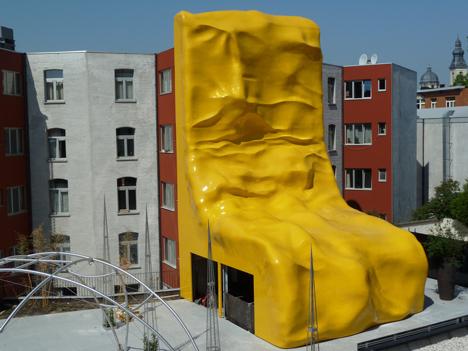
Named CIRBUATS, the huge sculpture is attached to the rear of Zebrastraat, a mixed-use building that houses art galleries, apartments, and a hotel and lounge. New apartments constructed recently behind the building had revealed windowless facades never intended to be seen, so Nick Ervinck was asked to place a large sculpture in front.
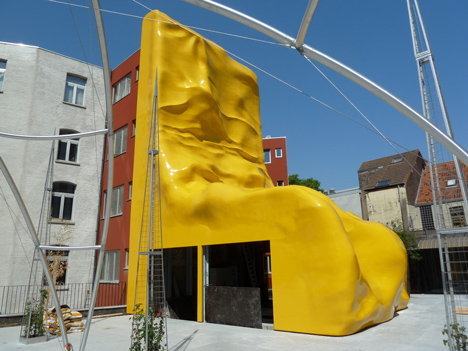
"For me it was really challenging to do something at that scale," he told Dezeen. "The idea was to put a bar inside the sculpture, so it was almost like hiding one sculpture underneath another."
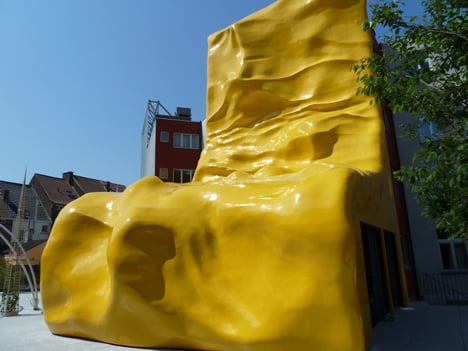
Describing how he came up with the idea for the blob-like form, Ervinck explained: "I started with the idea of water, then came more to the idea of fabric, of a cloth or a veil."
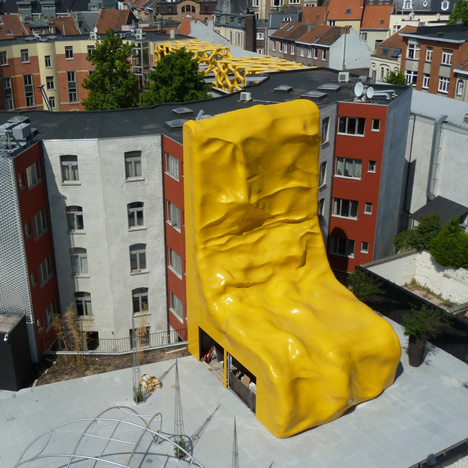
The bright yellow form folds around the new bar - set to be fitted out by designer Lowie Vermeersch - and its colour matches an earlier installation created by the artist on another side of the building.
The structure was assembled from seven parts that were manufactured offsite and then hoisted into place. "We had to close one of the most important streets in the city for two days," revealed Ervinck.
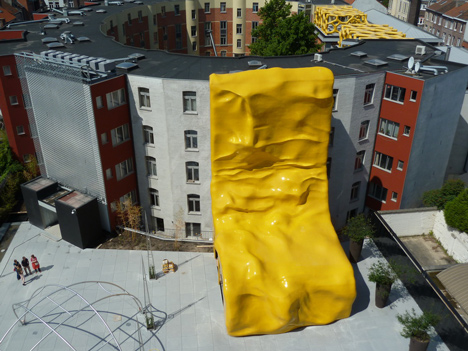
The main body is made from polyurethane foam, which was sculpted by hand based on a computer-generated design. The exterior was then built up with a layer of fibreglass and painted polyester.
"It still fells like one really big veil," said Ervinck, reflecting on the completed form. "On one hand it's very much a sculpture, but on the other it's completely figurative, like a huge piece of fabric that's glowing."
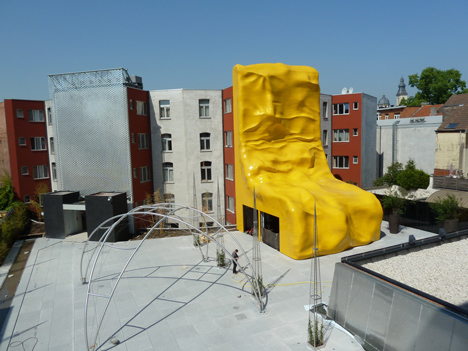
Other installations to feature on Dezeen recently include an arched screen with hundreds of building-shaped holes and a melting brick wall. See more art and design installations »
Here's some more information from the designer:
CIRBAOTS
With this monumental project for Zebrastraat in Ghent, Ervinck bundles some current topics and personal interests: the architectural discourse between blobs and boxes, the art historical motif of the veil and the social and political tension between public and private, and outside and inside. This monumental sculpture should be a meeting point that bridges the separation between public and private, and between inside and outside. Moreover, it elevates the "rear" of the building or neighbourhood to a visual attraction.
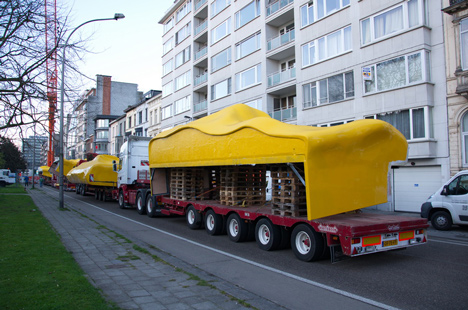
Blobs and boxes
This monumental sculpture is so to speak grafted on the building and illustrates the contrast between the conventional models of the architecture (box) and the virtual design (blob). It is a contrast between rigid and organic forms and between physical and virtual. While most architects favour only one single of these schools in design, Ervinck choose with this design resolutely for a third way: the synthesis of both. Inspired by architects like Will Alsop and Greg Lynn, Ervinck explored the potential of digital design methods for the sculpture. For Zebrastraat he designed an organic form that seems to loosen the cube, but at the same time can not exist without the latter. This tension between the solidity of the base on the one hand, and the sculpture coming to life on the other, was already treated by Ovid (the sculptor Pygmalion creates Galathea from a cut stone) and in the 17th century, beautifully visualised by Bernini (Daphne's legs are half part of the base and half free). In the work of Nick the blob and the box form as it were two identities that attack, embrace and reject each other and merge together. This monumental work is not only a study of the media sculpture, it also challenges its existence conditions (mass, dimension, matter and gravity) in a radical way.
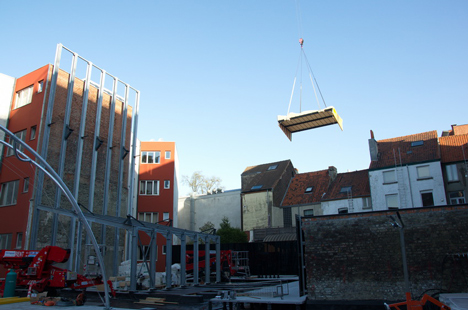
Veil
Covering with fabric or a veil is an art historical theme with a long tradition. Pliny associated the curtain with illusionism and interactivity: he described how he fooled the artist Parrhasius Zeuxis by asking him to slide a painted curtain. The contemporary artist Michelangelo Pistoletto worked further on this tradition with his work 'Green Curtain' (1962-1965). The artwork for Zebrastraat is also about such illusion: using digital design and mathematical formulas the illusion of a fabric is created. This substance seems loosely draped over the underlying matter. It invites so to speak the viewer to lift the veil and to see what lies hidden beneath it. Associated to this are questions about the role of art in society and the imperative of participation and engagement of the viewer relative to the artwork. This artwork also refers to the Belgian identity which is intertwined with surrealism.
The German Renaissance painter Lucas Cranach accented the nakedness of his figures by a transparent veil. The veil is a very ambivalent pattern: firstly it hides the information, but at the same time it also emphasises what is hidden under the cloth. The sculpted fabric stands for transformation: it conceals and reveals the matter. This art work for Zebrastraat is finally a monumental poetic ode to the volume and shape: the fundamentals of sculpture.
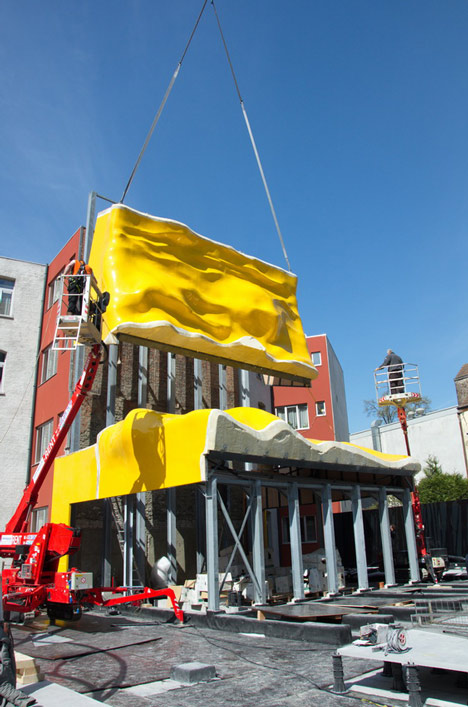
Public and Private
Because this work responds to the social specificity of the real estate project in Zebrastraat, it has, besides its artistic relevance, also a profound social significance.
First Ervinck plays with the concept of 'rear'. These facades were originally not intended to be seen from the street. Now the land was bought, these facades play a new role in the streetscape. Ervinck wants to upgrade the – often unappreciated – rear of the building, and even attribute it a public function. With this work he also thinks about how art can be integrated into society.
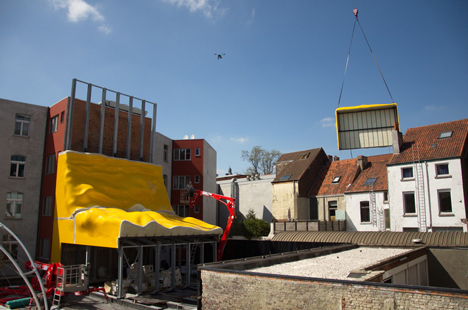
By "covering" part of the facade with a veil, Ervinck reflects secondly on the processes of spatial appropriation. Its imposing structure reflects an increasingly problematic division between public and private, and a privatisation process that since the 15th century has become increasingly compelling. Claiming common property in order to transform it into a profitable product is today common practise in all segments of society. The protection of certain areas (think of Fortress Europe) – and the related division between "us" and "them" – is surmounted by a political act. This separation is always characterised by a tension between protection and confinement. Ervinck does not want to draw a radical line between inside and outside. He would rather create a meeting point, which will functionally be realised by the installation of a bar at the bottom of the sculpture. Just as the world has not gone away, when you close your eyes, the architecture does not disappear when it is shielded. It has been transformed and is part of the common area.